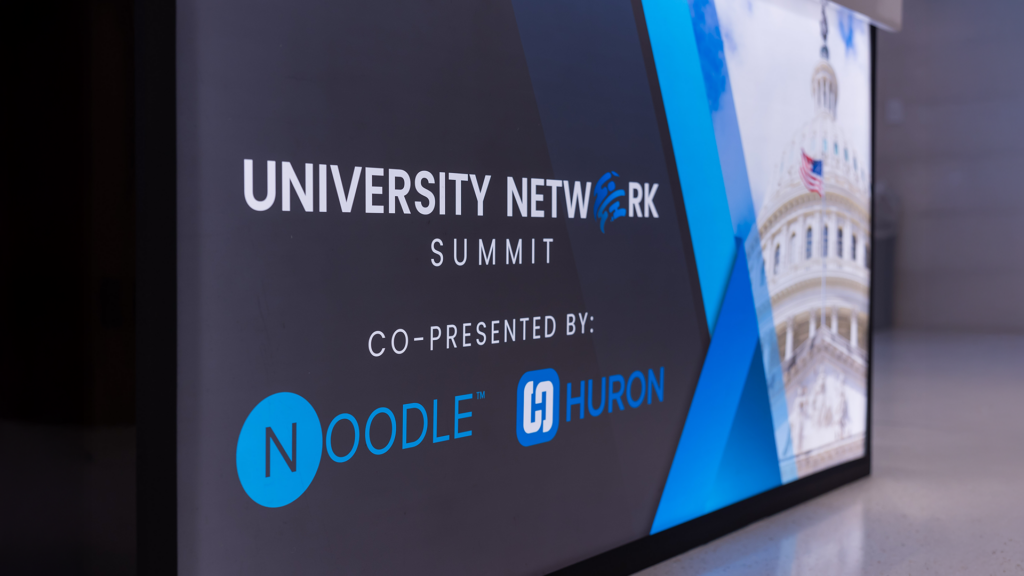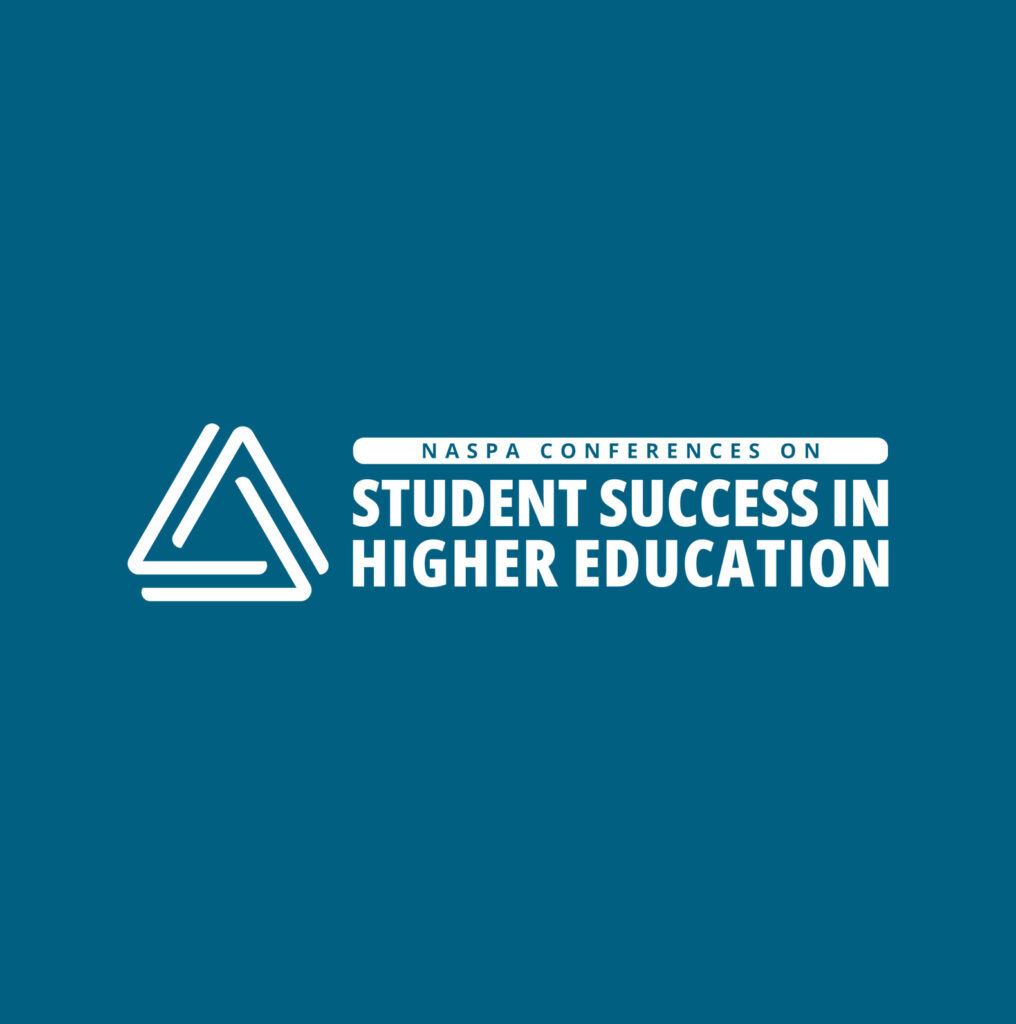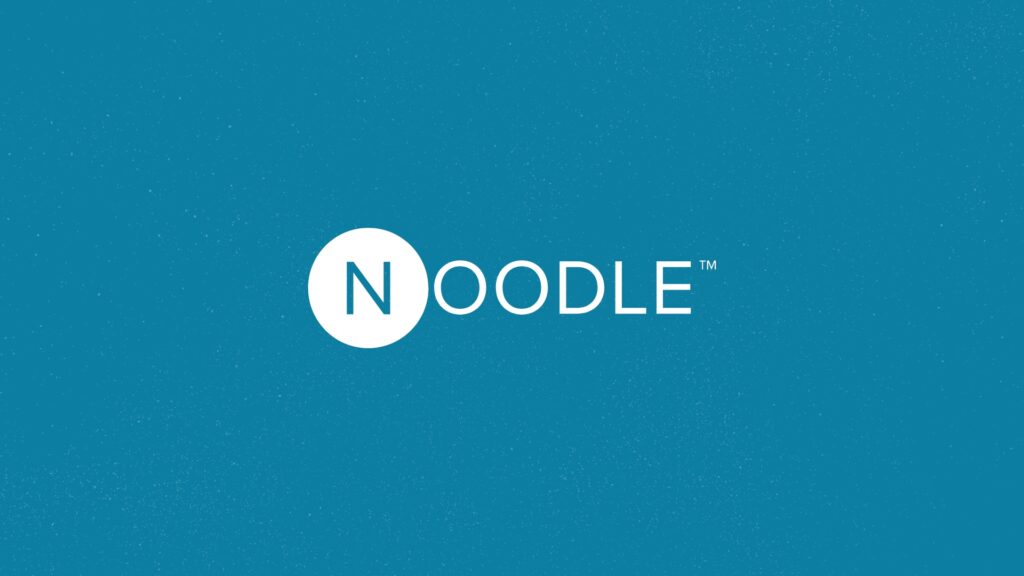Higher education faces mounting challenges, from increasing enrollment and cutting costs to improving outcomes, all within a complex financial and political landscape. The University Network Summit 2025, co-hosted by Noodle and Huron, brought together industry leaders to tackle these critical issues head-on.
Over the course of three days, beginning Wednesday, March 5, the summit provided a platform for higher education leaders from across the nation to connect, collaborate, and exchange ideas. Discussions focused on innovative strategies, meaningful partnerships, and reimagining approaches beyond traditional online program management models, offering fresh perspectives on the evolving state of higher education in the U.S.
Memorable Remarks Overheard
- “People are finally saying the quiet parts out loud!”
- “In other industries, networks win … always.”
- “Higher education uses 19th century methods administered by 20th century adults for the benefit of 21st century students.”
- “DEI is dead.”
- “We need to make higher education a part of life, not just something you do on the way to life.”
- “The new administration may represent our final disruptive challenge.”
- “I think what we’re looking ahead to is more destruction than disruption.”
- “Politics with higher education are as impactful as politics on the outside.”
DAY 1
5 p.m. – Keynote Panel
6 p.m. – “Higher Ed in the Headlines: What’s Driving the Conversation?”
See full agenda details and participants.
The first day of the Summit began with a Keynote Panel moderated by Noodle CEO John Katzman and featuring Former Under Secretary of the U.S. Department of Education, James Richard Kvaal, and Ted Mitchell, President of the American Council on Education. Topics included everything from the role of employers in higher ed to the growing influence of private investment and alternative funding models. Many of these were explored in greater detail in subsequent sessions.
Following the Keynote Panel, a group of journalists and analysts convened for “Higher Ed in the Headlines: What’s Driving the Conversation?” The panelists weighed in on the future of institutional funding, potential policy shifts, and the changing higher ed landscape—some predictions were optimistic, others were bluntly realistic. Either way, one thing was clear: change is coming fast.
- Conversations on closures & consolidations are no longer taboo
Leaders are openly discussing how to adapt to declining enrollments, financial constraints, and shifting student expectations, and that means rethinking institutional models, exploring strategic partnerships, and making tough but necessary decisions to ensure long-term sustainability. - Employers should and are becoming key players in education
Companies are no longer just end users of talent; they’re actively shaping curriculum, funding workforce development, and demanding stronger ROI from partnerships with institutions. - Higher ed is entering an era of customization
Traditional degree paths are being challenged by more flexible, modular learning experiences—one panelist likening the future of education to a Spotify playlist, built by and for the learner. - Federal & state policy gaps are widening
With uncertainty at the federal level, states and employers are stepping in to drive workforce alignment and fill gaps in funding and program development. - Alternative funding and business models are emerging
Institutions are being pushed to prove value, lower costs, and rethink traditional funding models, with private investment and alternative revenue streams playing a growing role. - The new administration seeks to reshape higher education
While there were few specific predictions about how higher ed will be impacted, the threat of funding cuts, the possible dissolution of the Department of Education, and free speech on campus were all raised and discussed. One point of unanimous agreement was that there will be an extended and potentially painful period of uncertainty. While this may be viewed as a copout in some circumstances, knowing that change is coming encourages institutions to be nimble and, as one panelist put it, “represents an enormous opportunity for more entrepreneurial leaders.” - Funding cuts today will have serious long-term impact
The immediate impact on graduate and doctoral students will be significant, but the loss or delay of those students achieving their professional goals will have a larger impact on society.
Day 2
9 a.m. “Online Learning in 2025: State of the Marketplace.”
10 a.m. “Whatever It Is, I’m Against It”
11 a.m. “Higher Ed Consolidation: Opportunities and Challenges over the Next Decade”
12 p.m. “Building a Culture of Innovation”
2 p.m. Concurrent Track Sessions
Track 1: “From Transactional to Transformational: How to Build Meaningful Partnerships”
Track 2: “The Great Enrollment Reset: Competing for Students in a World That’s
More Global, More Digital, and More Uncertain”
3 p.m. Concurrent Track Sessions”
Track 3: “Students Are Not Okay—So What Are We Going to Do About It?”
Track 4: “Regulation vs. Innovation: Conflict, Collaboration, or Chaos?”
See full agenda details and participants.
Over the course of the day, many topics were discussed with a variety of inspiring, motivating, and occasionally unsettling takeaways.
- Online learning isn’t the innovation it once was
The market is saturated, students expect more than just convenience, and simply offering online programs isn’t a competitive edge anymore. Despite this, many institutions lack specific plans for growing and evolving online learning other than some “strategic budgeting” or the adoption of very high level “pillars” that don’t really help with implementation.
The real opportunity? Rethinking delivery models—blending high-impact experiences, workplace integration, and personalized learning that goes beyond just putting courses on a screen. “The way online learning exists today will soon be the next 90s discussion board”. - We need to focus on learners as “consumers.”
Students aren’t just enrolling—they’re making an investment. We need to start seeing them as “consumers” who demand more than just a degree—they expect real value, flexibility, and measurable outcomes. “My university is treating students as passive recipients rather than active consumers, and we’re missing a massive opportunity to deliver the value they’re looking for. - Innovation should be driven by more than revenue goals
“I feel stuck!” Many charged with the challenge of how to evolve programs and policies face multiple internal obstacles. Many institutions don’t actually want innovation; they want quick revenue. “I made this trip to get unstuck and inspired. I’m leaving here with plans to meet with [NAME] so he can walk me through what he did to actually drive innovation and a new business model.”
Successful innovation also requires a certain “professional immunity.” In other words, the most successful leaders of and advocates for innovation will be those who have the freedom to be creative and challenge the status quo without fear of losing their jobs.
Key considerations when building a culture of innovation include:- Continuous improvement
- Scalability
- Innovating culturally as well as procedurally
- Engaging with students as well as faculty and administrators
- Look to small- and mid-sized schools for leadership
Mid-sized and smaller schools that do not have the resources of larger institutions cannot afford to continue the status quo while others figure out the next steps. Large and financially-secure institutions have less incentive to innovate and can comfortably wait for more vulnerable institutions to succeed or fail and then adopt their more efficacious policies and procedures.
Similarly, smaller institutions are more inclined to seek guidance from the constituencies they serve. Admitting gaps in knowledge and understanding of “customers” is not a sign of weakness, but rather it is the most accurate representation of our mission. Likewise with embracing some of the practices of the for-profit business world such as hiring from outside the industry and strategically embracing partnerships and outsourcing. - Buy? Sell? Merge? Partner? High finance in higher education
“If you’re a financially sound institution, and you’re not looking at strategic mergers and acquisitions, you’re missing out.”
Since 2020, financial struggles have caused around 100 private non-profit institutions to close or merge, impacting 200,000 students and $2 billion in endowments. Current market conditions suggest this trend will only accelerate.
While alignment of these attributes eases transition, differences in culture, policies, and procedures should be viewed as opportunities to review legacy systems and explore new and better ways of doing business. That said, would-be acquirers should recognize that they will inherit responsibility for addressing the unresolved challenges faced by the acquired organization.
With more than 4,000 institutions—all claiming to be unique and predisposed to competition over collaboration—the U.S. higher ed market is primed for extensive consolidation with a need for a more enlightened view of partnerships. When considering a joint venture of any kind, institutions must be mindful of four key areas that may represent synchronicity or conflict between the parties:- Mission
- Legacy
- Assets
- People/Culture
- While alignment of these attributes eases transition, differences in culture, policies, and procedures should be viewed as opportunities to review legacy systems and explore new and better ways of doing business. That said, would-be acquirers should recognize that they will inherit responsibility for addressing the unresolved challenges faced by the acquired organization.
DAY 3
9 a.m. The Presidents’ Perspective Panel
10 a.m. “Hot Off The Hill”
See full agenda details and participants.
The Summit’s final day began with a roundtable discussion among university presidents representing a range of mid-sized private institutions with academic portfolios that are distinct from one another and where the role of online learning is emerging, expanding, or mature.
The roundtable was followed by a presentation and discussion with Phil Hill of On EdTech exploring some of the actions of the new administration and their impact on higher education and learning institutions of all types.
What we heard:
- Learn from the experience of others
Higher education leaders “get way too obsessed with originality.” There is no shame in seeing what works somewhere else and either copying or adapting that behavior to your own situation. - Consolidation has value from both sides
Smaller institutions should always be prepared to entertain opportunities to merge or be acquired, but must understand the tradeoffs between increased resources and sacrificed autonomy. Larger institutions should avoid the “corporate raider” mentality, taking a broader view of M&As with concentration on mutual benefit rather than just spreadsheet math. - The DOE is not going away
Despite fears within higher education and threats/promises from the administration, the Department of Education will be fundamentally changed but not dismantled completely. Additionally, 60-day reviews that are due in late April and May will significantly inform the restructuring and/or downsizing to follow. - DOGE isn’t going away either
The resolution of court cases related to layoffs and funding cuts for NIH, USAID, and others will begin in April and provide more clarity going forward, but we can expect an extended period of uncertainty that will hamper the abilities of many institutions to plan for the future. The spate of additional cuts and reprimands since the Summit underscores this truth.
Three days. 12 interactive sessions. More than 40 presenters, moderators, and panelists. And more than 150 higher education executives, industry innovators, policymakers, and community builders. All coming together to have frank, critical conversations, share successes and fresh ideas, and help each other to mold the future of higher education.



